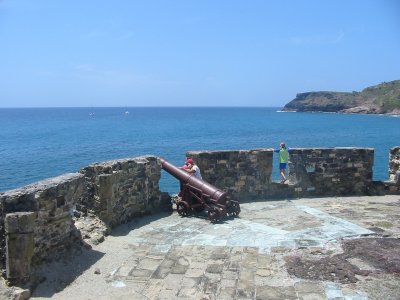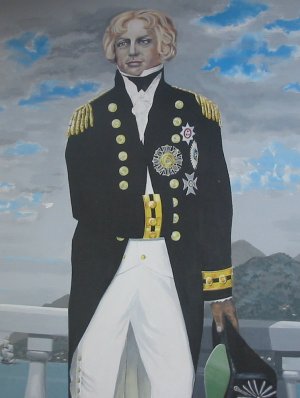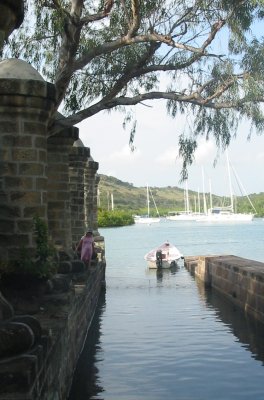Nelson's Dockyard - a report by Anna

Tamarisk
Thu 30 Mar 2006 16:52
|
In 1957 Desmond Vernon Nicholson came to English
Harbour and found it in ruins. The dockyard was a ghost town with cobwebs,
banging shutters and sagging walls. Bats flew around and goats, lizards and mice
were the only inhabitants. But the place had the dignity and elegance of
better days - heavy cannons lay about, massive brick buildings held memories of
past times. Sweeping away the dust and cobwebs the Nicholsons moved into the old
Paymasters House to refit Mollyhawk - their schooner, which was to
become the first charter yacht in the Caribbean. Hardly anybody knew they
were there.
When the English first arrived in Antigua they were
looking for somewhere to base their fleet. It was important they had a fleet
here to protect the British ships, islands and trade. English Harbour was a
good choice because it was a natural Hurricane Hole. That's a harbour or
anchorage where it is safe to keep your boat during the hurricane season. These
usually have hills and mangroves and a narrow inlet protecting it from the wind
and the sea.
 Fort Berkeley stands at the mouth of
English Harbour.
When Nelson arrived in English Harbour in 1784
England had already established major trading routes in the area. The main
export was sugar.
(Sugar had been such a rare commodity that only
rich people could afford it. Queen Elizabeth I made a special paste which she
smeared all over her teeth, which made them rotten and black so people
recognised that she had enough money to buy sugar.)
 Portrait of Nelson after he lost his
arm
Nelson was Commander In Chief in Antigua from 1787.
Everyday he had six pails of water poured over his head when he woke up. He
drank two pints of goat's milk everyday and walked a mile every evening. He
said he was 'woefully pinched' at night by mosquitoes. And called English
Harbour an 'infernal hole'.
 Admiral's House - now the museum,
with bust of Nelson to the right of entrance.
 Copper and Lumber store - now a
hotel
 Paymaster's Office - now home for
a coffee shop (where I have been working), electricians, yacht brokers and
internet cafe
 Sawpit shed and cabin - the ramp was
used to roll logs into the building. It is now a sail repairers.
 Sail-loft. There used to be a house
on top of the pillars and the boats would sail in underneath in the little
cut.
 Boat House and Joiner's Loft - now
part of the Sunsail Charter HQ
 Admiral's kitchen - now a
bakery
Life onboard a ship in Nelson's
day
Life onboard a ship in Nelson's day was not
glamorous nor easy. Here are some things you should know:
Ship's Code of
Rules
No Theft
No Lying
No Mutiny
No Swearing
No Desertion
No Murder
No Sedition
No Blasphemy
All violators will be dealt with
swiftly and severly according to the Captain's Judgement.
Food was bad on a ship. Most of the time the bread
was full of weevils. When the coffee supply ran out, sailors would grind up
burnt toast and put it in a cup of lukewarm water. The water was bad as
well and the beer was sour.
In those days, anaesthetic was unknown. Amputation
was the most common way of dealing with an infected limb. Surgeons
would make the patient drunk, give them a bit of cloth or leather to bite
on and would hold them tight down onto a bed or chair. After a battle there
would be queues of people waiting for amputation. Many of them bled to death
while waiting. There was also scurvy onboard. This started with a rash, then
your hair would fall out, then your teeth would fall out. Scurvy was caused
by a lack of vitamin C, most commonly found in fresh fruit and
vegetables.
Nautical facts
Gambling was common onboard a ship. The dice were
made out of bone or lead.
Sailors preferred Spanish coins because they were
made of either silver or gold.
The _expression_ 'keep it under your hat' comes from
the sailors keeping their secret tobacco under their hats so no one could
find it. They would chew the tobacco and when it had run out, they would chew
the lining of their hat.
The _expression_ 'no room to swing a cat' comes from
the punishment onboard a ship of lashes from a stick with 9 pieces of
rope with knots on the end called a 'cat of nine tails'.
By the time of the Battle of Waterloo, England
owned Jamaica, St Kitts, Barbados, Nevis, Antigua, Montserrat, St Lucia, the
Virgin Islands, Dominica, Grenada, St Vincent, Tobago and Trinidad.
English Harbour Now
Desmond Nicholson gained publicity for the Dockyard
and a restoration project was established. Lots of people helped with money,
including the Queen. Now it is a big attraction for tourists, who pay
towards the upkeep. Yachties contribute via berthing fees. When it was restored
it was not made to be exactly like it was before but to be a place where
yachtsmen and tourists could come but there would still be a feel of the olden
day dockyard. It is now a national park. Desmond Nicholson died earlier this
year.
Photos and text by Anna Fenton Jones (with
help typing from Tim)
|